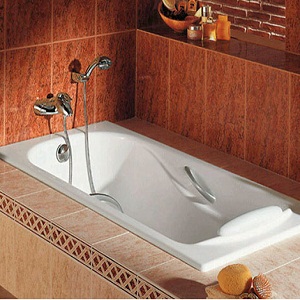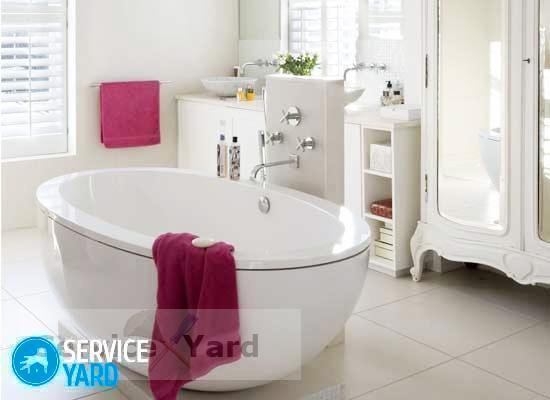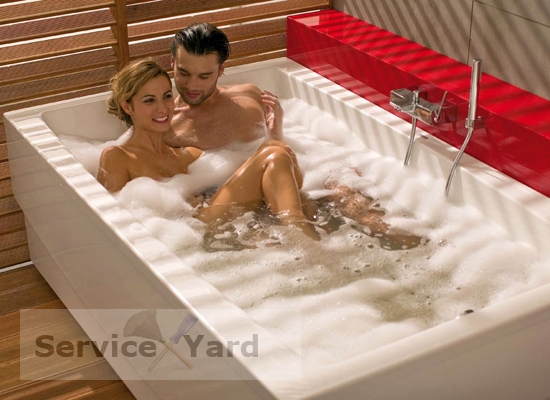How to whiten an old bath

The bathroom is one of the important places in the house. Cleanliness, beauty and, most importantly, a good mood for the whole day are born here. But often it spoils from contemplation of the consequences of the old water supply system, sediment of poor-quality water, which is why the question arises - how to whiten the old bathtub from all this “beauty” in the form of a coating of rust and lime. In this article, we will share some tricks with you so that you can quickly and easily achieve a crystalline whiteness of the bathtub, remove roughness and wash yellowness.
to contents ↑What bathtubs are there?
 Before you start cleaning the bowl, specify which material it is made of. Each species requires a separate approach.
Before you start cleaning the bowl, specify which material it is made of. Each species requires a separate approach.
There are several types of bathtubs:
- cast iron;
- metal;
- plastic;
- with acrylic coating.
to contents ↑Important! Most often installed in modern apartments and private houses cast iron and acrylic bowls, as they are more durable, attractive, but at the same time they retain heat very well and do not create noise discomfort during water intake or showering.
How can you bleach a cast-iron bath?
Do you have a cast-iron bathtub “not of its first youth”, covered with small cracks and a yellow coating of water due to hard water? If you want to return to her original attractiveness, you will need such means:
- sponge on one side with a hard surface;
- cleaning powder;
- chlorine based bleach;
- lemon acid;
- oxalic acid;
- vinegar;
- soda;
- rust remedies;
- solvent;
- sandpaper.
How to whiten an old cast-iron bath?
We offer you some effective ways to clean the cast iron bath. Choose the lightest and most inexpensive for you and take it on your note for regular cleaning.
Method 1
If you have old plumbing and you are not afraid that it might go bad, use abrasive-based cleaning powders and an iron bristle brush:
- Remove rust with a brush.
- Rinse the bath.
- Apply oxalic acid diluted with water in the form of slurry. This tool is considered less aggressive compared to others.
- Leave the mixture on rusty stains for 30-40 minutes.
- Rinse off with water.
Method 2
This method is considered the most economical and more aggressive:
- Wet the bath.
- Sprinkle an abrasive cleaner over the entire surface of the bathtub.
- Leave for a while, let it soak.
- Places with a build-up of plaque, process more intensively with an iron brush.
- Rinse with clean water.
Method 3
Use the most versatile tool - baking soda. It is used to whiten even the most old spots and rust on plumbing:
- Breed calcined and baking soda in a ratio of 1: 1, the amount of powder depends on the area of the surface being cleaned.
- Apply the mixture and leave for 5 minutes.
- Make a solution of bleach and vinegar, fill the surface of the bath for another 2 hours.
- Rinse well with running water ..
Method 4
Use cream-based products, they have more gentle abrasive substances. This method is suitable for newer plumbing:
- Apply cream gel to a sponge.
- Thoroughly treat the inside of the bowl with the substance.
- Wait a few minutes.
- Rinse thoroughly with water.
Method 5
Modern means, such as: CIF, Mr. Muscle, Sanoks, San Klin, Domestos, will help you clean the bath from old impurities. Use them this way:
- Dampen the walls of the bath with the product so that the solution completely covers the surface, and not lightly with thin smudges.
- Leave for a while, depending on surface contamination.
- Rub the contaminated area thoroughly with a sponge.
- Rinse with water.
Method 6
In order not to injure your sense of smell with chlorine fumes from cleaning products, refer to folk recipes:
- Rinse the bath several times with hot water or draw boiling water and leave for 10-15 minutes.
- Drain the water.
- Wipe the surface of the bath with a sponge with ammonia.
- Leave to soak for 20-30 minutes.
- Then apply detergent or soda to the surface and begin to erase the coating in a circular motion.
- Rinse the bath.
Important! If the bath does not achieve the desired result, apply any product on the surface that is labeled that it is used to get rid of plaque or rust.
Method 7
 This option is suitable for the lazy or those who simply have a catastrophic lack of time for a long cleaning:
This option is suitable for the lazy or those who simply have a catastrophic lack of time for a long cleaning:
- Get a full bath of hot water.
- Add concentrated oxygen purifier.
- Leave it overnight.
- Drain the water in the morning.
- Rub the inside of the bowl slightly with a sponge to remove any residual deposits.
- Rinse well with shower water.
to contents ↑Important! Replace bleach with citric acid (about 30 sachets) or a bite. This option is also very effective, especially if the plaque is not very old.
How to bleach a cast iron bath with enamel coating?
Over time, the enamel of the bath becomes covered with plaque, rusty spots and begins to darken, poor-quality water leaves traces of smudges. Special chemicals and aerosols will come to your aid in order to whiten the bath without damaging the enamel coating.
Method 1
Use ceramic cleaners:
- Apply a creamy suspension to the bath walls with a sponge or spray with an aerosol.
- Wipe plaque from the walls of the bathtub in circular motions.
- Rinse the surface with water.
Important! Do not use a wire brush, as this may damage the coating and thereby cause corrosion.
To wash the bath, use a variety of cleaning sprays that can be used on a smooth surface of plumbing:
- Moisten the surface of the bathtub in advance.
- Spray the spray.
- Leave the product for 10-15 minutes to influence the contamination.
- Wipe the inside of the bowl with a soft sponge.
- Rinse off the cleaning agent with warm and then cold water.
How to whiten an acrylic bath?
The acrylic bath does not require special care, but still consider the following recommendations:
- clean its surface with a soft brush;
- use only liquid cleaners and mild detergents;
- Do not take products based on acids, alkalis and chlorine, so as not to melt the coating of the acrylic bath.
- Since acrylic plastic is very delicate, do not use abrasives in its cleaning - they leave microcracks in which dirt will enter.
Important! Ideally, you should choose special detergents designed just for acrylic. With this approach, you can effectively get rid of any stains, and the process itself will be much shorter than when using inappropriate pastes, gels, powders and sprays.
The general scheme for cleaning an acrylic bath is as follows:
- Apply dishwashing detergent to the surface of the bath.
- Spread over the entire surface.
- Wipe the inside of the bowl with a soft sponge without an abrasive surface.
- Rinse with running water.
If your bathtub is covered with old limescale, use a special repair kit for polishing acrylic surfaces. It includes a set of sandpaper of different grain sizes and polishes for acrylic surfaces, along with detailed instructions for use.This procedure will look like this:
- Wet the surface and sandpaper with water.
- Sand the bath in a circular motion.
- When switching from large to smaller emery cloth, clean the surface well from dust and rinse.
- At the end of the work, use finishing polishing with a special paste for an acrylic surface.
to contents ↑Important! So that the bathtub is not matte, but glossy, use only the specialized acrylic polish, which is included in the kit, and not other mixtures. Similarly, rust spots, animal scratches and other damage to acrylic are eliminated.
Useful Tips
to contents ↑Stock footage
- Wear protective gloves and a respirator when handling acid- and chlorine-containing substances to avoid burns to the skin of the hands and respiratory organs.
- Carefully read the instructions for applying cleaning chemicals to different types of surfaces. Especially note the processing time - it can dramatically differ.
- How to choose a vacuum cleaner taking into account the characteristics of the house and coatings?
- What to look for when choosing a water delivery
- How to quickly create comfort at home - tips for housewives
- How to choose the perfect TV - useful tips
- What to look for when choosing blinds
- What should be running shoes?
- What useful things can you buy in a hardware store
- Iphone 11 pro max review
- Than iPhone is better than Android smartphones



